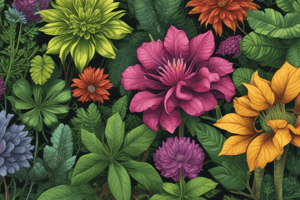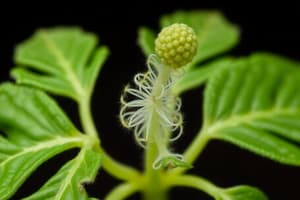Podcast
Questions and Answers
What is the primary function of xylem in vascular plants?
What is the primary function of xylem in vascular plants?
- Anchoring the plant and absorbing water.
- Facilitating gas exchange in leaves.
- Carrying water and dissolved minerals from roots to stems and leaves. (correct)
- Transporting sugars from leaves to other plant parts.
Non-vascular plants, like ferns, possess specialized vascular tissue for efficient transport of water and nutrients.
Non-vascular plants, like ferns, possess specialized vascular tissue for efficient transport of water and nutrients.
False (B)
How did the evolution of seeds contribute to plant adaptation on land?
How did the evolution of seeds contribute to plant adaptation on land?
Seeds eliminated the need for water for gamete transfer, providing a means for widespread dispersal and survival of plant embryos.
In angiosperms, the seeds are protected within a structure called the ______, which also aids in seed dispersal.
In angiosperms, the seeds are protected within a structure called the ______, which also aids in seed dispersal.
Match the plant adaptation to its function:
Match the plant adaptation to its function:
Which characteristic is exclusive to angiosperms compared to gymnosperms?
Which characteristic is exclusive to angiosperms compared to gymnosperms?
Monocots are characterized by having two seed leaves (cotyledons) within their seeds.
Monocots are characterized by having two seed leaves (cotyledons) within their seeds.
Describe how the arrangement of vascular bundles differs between monocots and dicots, and how this affects the plant's structure.
Describe how the arrangement of vascular bundles differs between monocots and dicots, and how this affects the plant's structure.
Which of the following accurately describes the transport of sugars in plants?
Which of the following accurately describes the transport of sugars in plants?
The primary function of stomata is to facilitate water absorption into the leaf.
The primary function of stomata is to facilitate water absorption into the leaf.
What is the main difference between annual and perennial plants in terms of their stems?
What is the main difference between annual and perennial plants in terms of their stems?
Water enters the roots from the soil via the process of _________ and is transported upwards through the _________.
Water enters the roots from the soil via the process of _________ and is transported upwards through the _________.
Match each plant structure or type with its corresponding description:
Match each plant structure or type with its corresponding description:
Which characteristic is typically found in monocots but NOT in dicots?
Which characteristic is typically found in monocots but NOT in dicots?
The zone of elongation in a root is where rapid mitosis of undifferentiated cells occurs.
The zone of elongation in a root is where rapid mitosis of undifferentiated cells occurs.
Name three functions of stems in plants.
Name three functions of stems in plants.
The waxy layer that protects leaves and reduces water loss is called the _________.
The waxy layer that protects leaves and reduces water loss is called the _________.
Why are needles advantageous for some plants compared to deciduous leaves?
Why are needles advantageous for some plants compared to deciduous leaves?
Flashcards
Plants
Plants
Multicellular eukaryotes with chloroplasts, fixed in place, and have cell walls of cellulose.
Plant Adaptations to Land
Plant Adaptations to Land
Protection from drying out, vessels for transport, and stems/leaves for support & photosynthesis.
Non-vascular Plants
Non-vascular Plants
Plants lacking a vascular system, limiting their size and requiring moist environments for reproduction.
Vascular Plants
Vascular Plants
Signup and view all the flashcards
Seeds
Seeds
Signup and view all the flashcards
Gymnosperms
Gymnosperms
Signup and view all the flashcards
Angiosperms
Angiosperms
Signup and view all the flashcards
Xylem
Xylem
Signup and view all the flashcards
Transpiration
Transpiration
Signup and view all the flashcards
Sieve tube elements
Sieve tube elements
Signup and view all the flashcards
Translocation
Translocation
Signup and view all the flashcards
Monocots
Monocots
Signup and view all the flashcards
Dicots
Dicots
Signup and view all the flashcards
Zone of Maturation
Zone of Maturation
Signup and view all the flashcards
Root Hairs
Root Hairs
Signup and view all the flashcards
Cuticle
Cuticle
Signup and view all the flashcards
Epidermis
Epidermis
Signup and view all the flashcards
Palisade Cells
Palisade Cells
Signup and view all the flashcards
Study Notes
- Plants are multicellular eukaryotes containing chloroplasts for photosynthesis.
- Plants are non-motile, fixed in one location, and possess cell walls made of cellulose.
- Plants exhibit responses to their environment, with the earliest plants living in water.
Plant Adaptations to Land
- Protection from drying out for leaves and stems.
- A system of vessels to transport water, nutrients, and wastes.
- Stems and leaves function to hold the plant up and conduct photosynthesis.
Non-vascular Plants
- These plants lack a system of vessels for transporting nutrients, water, or waste.
- They were the earliest land plants
- Reproduction requires a moist surface for gametes to unite.
- Non-vascular plants reproduce via spores, not seeds
- Osmosis and diffusion facilitate nutrient movement between cells, limiting their growth.
Vascular Plants
- Ferns represent the first vascular plants.
- Vascular tissue enables material transport within the plant, promoting taller growth.
- Ferns have true roots for anchorage and absorption.
- Fern leaves are photosynthetic for energy production and gas exchange.
- Ferns reproduce with spores.
Seed Plant Evolution
- Seeds provide a means of sexual reproduction without water for gamete transfer.
- Seeds contain a fully developed embryo, a food supply, and protective coat.
- Gymnosperms produce "naked seeds" like pine cones.
- Angiosperms are flowering plants with seeds protected in fruit, attracting animals for seed dispersal.
- One pollen fertilizes each seed/ovule.
- Pollen also fertilizes the ovary, which becomes the fruit.
Monocots and Dicots
- These are two classes of angiosperms, differentiated by seed leaf number.
- Monocots have one seed leaf, and dicots possess two.
- Angiosperms share plant parts but differ in organization, affecting root, stem, and leaf structures.
- Vascular bundle patterns in roots, stems and leaves are how theses two classes differ.
Vascular Bundles
- Two types of vessels comprise a vascular bundle: xylem and phloem.
- Xylem transports water and minerals from roots to stems, leaves, and flowers.
- Phloem transports sugars between plant cells.
Xylem
- Xylem transports water, forming from dead tracheid cells.
- Water moves into xylem in the roots by osmosis.
- Transpiration is the process where water evaporates from leaves.
Phloem
- Phloem facilitates sugar transport, forming from living sieve tube elements.
- Translocation is the process by which sugar, dissolved in water, moves throughout the plant.
Monocots and Dicots Compared
- Monocots have fibrous, networked roots; dicots have taproots.
- Monocots have one seed leaf; dicots have two seed leaves.
- Monocots have scattered vascular tissue; dicots have vascular tissue in an outer ring.
- Monocots have parallel leaf veins; dicots have a network of leaf veins.
- flower parts of Monocots are in multiples of 3; petals of Dicots are in multiples of 4 or 5.
Root Functions
- Anchoring the plant
- Absorbing water and minerals
- Protecting against soil erosion
- Transporting water to the plant through xylem
Root Zones
- Zone of Maturation: cells differentiate into specialized cell types.
- Zone of Elongation: increasing root depth.
- Meristematic Region: area of rapid mitosis of undifferentiated cells.
- Root Cap: protects the meristematic region.
Absorption in Roots
- Root hairs, extensions of the root epidermis, expand surface area for absorption.
- Water enters roots via osmosis and flows through the xylem.
- Nutrients like nitrates, phosphates, potassium, and magnesium dissolve in water and are absorbed by the roots.
Stems
- Annual stems, found on plants that grow from seed every year, are green.
- Woody stems are typical of perennial plants like shrubs and trees.
Stem Functions
- Holding leaves up to receive light
- Transporting water and minerals in xylem.
- Transporting dissolved sugar in phloem.
- Specialized stems for asexual reproduction or starch storage.
- Stolons (runners): asexual reproduction (e.g., strawberries).
- Rhizomes: underground stem buds for asexual reproduction (e.g., irises).
- Tubers: starch storage (e.g., potatoes).
Leaf Functions
- Trapping light energy for photosynthesis to produce glucose.
- Exchanging gases (CO2 and O2).
- Water loss through transpiration aids water pull from roots.
- Serving as food, shade, habitat, and oxygen source for various organisms.
Leaf Types: Deciduous vs. Needles
- Deciduous leaves are wide for maximizing light capture and flat to increase surface area for gas exchange via diffusion.
- Needles have features that are advantageous:
- Waxy coating to save water
- Tough to eat
- Photosynthesize year-round
- Low wind resistance, surviving ice and snow
Leaf Structure
- Cuticle: waxy layer protecting from water and gas loss.
- Epidermis: transparent cells for sunlight penetration, providing mechanical strength with stomata and guard cells on the lower epidermis.
- Palisade Cells: contain large numbers of chloroplasts with chlorophyll, the main site of photosynthesis.
- Stomata: gas exchange (CO2 in, O2 out), water vapor release, and regulation of gas exchange according to CO2 needs. Open during the day and closed at night.
Spongy Mesophyll
- Loosely packed cells with air spaces for gas diffusion.
- Water vapor moves into the air spaces and exits through stomata (transpiration).
Vascular Bundles
- Xylem and phloem are found in leaf veins.
- Xylem carries water and minerals to leaf cells.
- Phloem carries glucose from leaf to other plant cells.
Studying That Suits You
Use AI to generate personalized quizzes and flashcards to suit your learning preferences.
Description
Explore plant characteristics, adaptations to land, and the differences between non-vascular and vascular plants. Understand how vascular systems enable plant growth. Learn about early land plants and the role of osmosis and diffusion.




